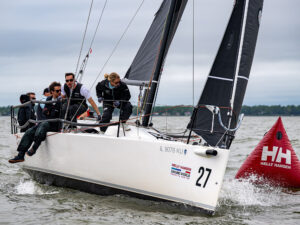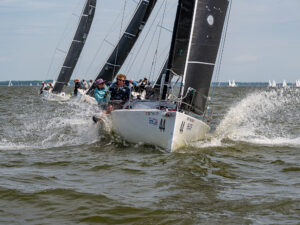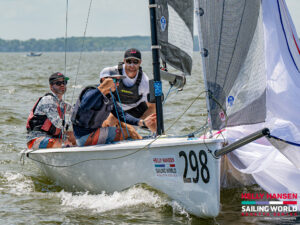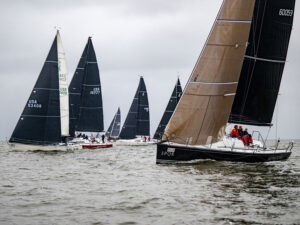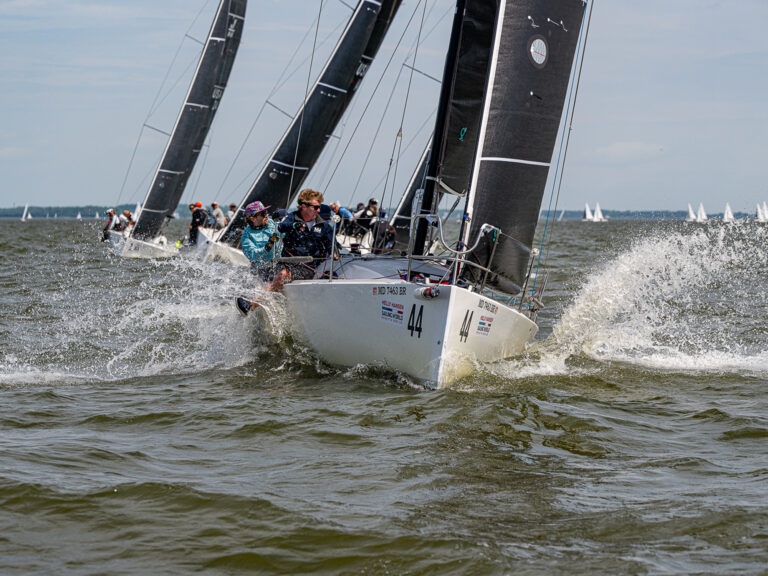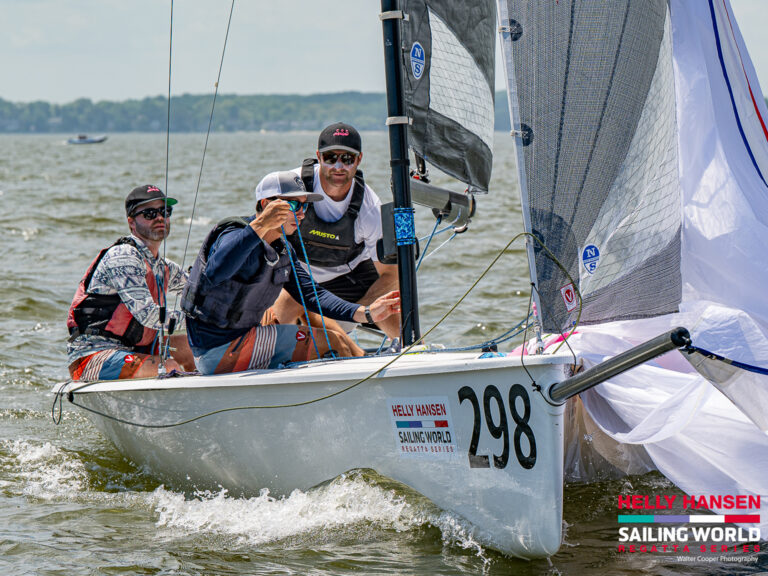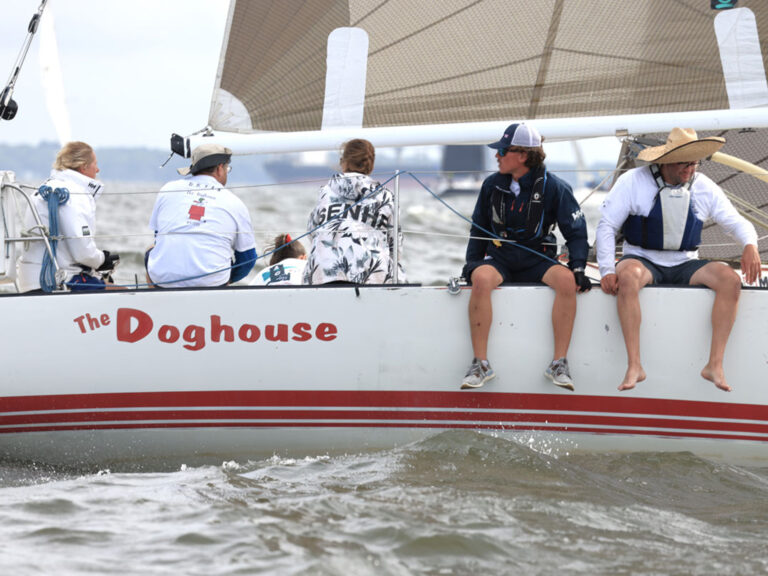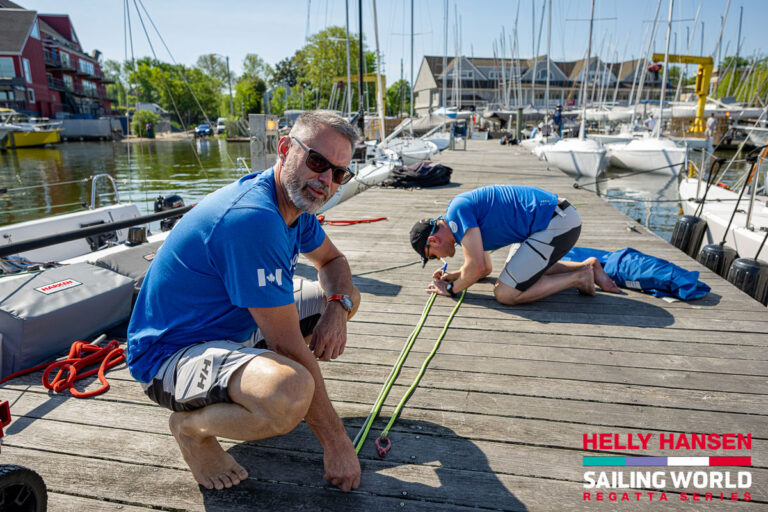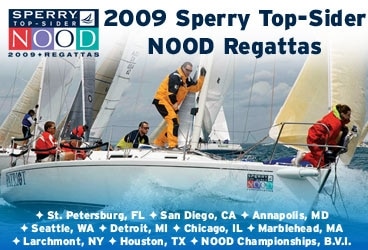
NOODBanner368
Results
Photos
Online Registration
Seattle NOOD Waiver Form (turn in at registration)
Seattle Schedule of Events 2009 NOOD
Seattle NOOD Boat Storage Plan 2009
May 18
This One’s for All the Marbles
Going into the last race of the 2009 Sperry Top-Sider Seattle NOOD, Dan Kaseler knew he needed to make something happen. His team on pTeron was tied for third in the 11-boat Melges 24 division, and he figured that, in order to win it all, he’d need to score better than the three third-place finishes he’d posted so far.
“Today when we went out we were like, ‘We’ve just got to give ‘er,'” says the 35-year-old from Port Angeles, Wash. “We were really aggressive at the start, really close to being over. But we just went for it all or nothing.”
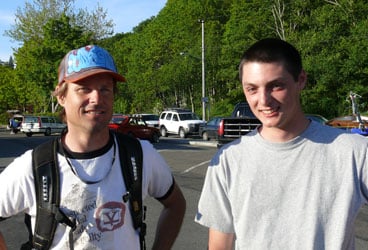
Michael Lovett| |Skipper Dan Kaseler (left), Josh Larson, and the rest of the pTeron team laid it all on the line to claim first place in the Melges 24 class and first place overall at the 2009 Sperry Top-Sider Seattle NOOD. For more photos from the event, click here| This do-or-die attitude paid big dividends for Kaseler and his crew, which includes wife, Jackie, brothers Sean and Greg Hallberg, and newcomer Josh Larson. The team’s daring start– “We were this close to the line,” says Larson, indicating the space between his thumb and index finger– propelled it to a first-place finish in the race, the class, and the regatta. For their overall victory, the team wins a trip to the BVI this November to compete in the NOOD Championships, courtesy of Sunsail.
“The BVI thing was definitely the highlight of the weekend,” says Kaselar. “This regatta has really good support from the sponsors.”
Kaseler is relatively new to the Melges 24 class, having only recently purchased his boat after a long hiatus from sailboat racing. He spends most of his time designing windsurfer sails. “My whole crew, we’re all windsurfers,” he says. “When I got this boat, I kind of told the rest of the guys, ‘Hey, let’s do this.'”
So does windsurfing inform his sailing? “It does. The kind of windsurfing I do is really different than racing around the buoys, but in terms of sail shapes and keeping the boat going fast, all that crosses over.”
The NOOD victory has emboldened Kaseler and crew to take their campaign nationwide, possibly beginning with next month’s Melges 24 Nationals in San Francisco. “Now all of a sudden we’re thinking about trying to get down to California,” he says. “We’re all pumped after this.”
May 17
For final results, click here.
Some Classes Did Race After All
While a lack of wind prevented racing for the majority of the 26 classes competing at the 2009 Sperry Top-Sider Seattle NOOD yesterday, the Deception Mini 12 class was able to complete one race over on Lake Union. For results of that race, click here.
At the party last night, I heard from my new pal Alan Bock from the San Juan 21 (Spinnaker) class, who reported that boats in his fleet decided to go out and sail despite the lack of wind. This hearty bunch actually got in a few informal races, staging their own starts between a channel marker and a conveniently located piece of driftwood. Where there’s a will, there’s a way, I guess.
May 16
Let’s Give ‘Em Something to Talk About
If you like sailing, it also helps to like standing around talking about sailing. Because, as anyone who’s been at it for any length of time can attest, talking about sailing is a huge part of our sport. With today’s postponement, there was plenty of time to do just that.
I talked about sailing with Eric Jesperson, skipper of the International Six Metre Gallant. To get to Seattle from his home in Sidney, which is on the south end of Canada’s Vancouver Island, Jesperson towed his boat behind his trawler like he’s done many times before. Each time he makes the 12-hour passage, he knows there’s a chance the racing might not go off as planned, but that’s no deterrent. “When you think about it,” says Jesperson, “we only race a few times a year, but we spend the rest of the year talking about it. So when we get the chance to actually race, we take it.”
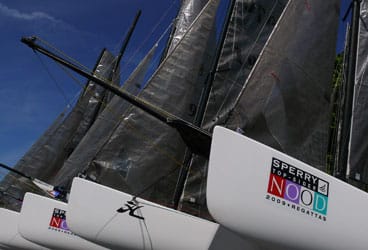
Michael Lovett| |If you squint, it almost looks like these Hobie Tigers are screaming off the starting line…| I had the chance to race on Don Atchley’s Hobie Tiger Highly Catfeinated in the International Formula 18 class. Unfortunately, like everyone else at the regatta, that opportunity did not materialize today. It’s too bad, because I was really looking forward to my first ride on a small catamaran, which, from the video Atchley sent me, looks like a real blast. As Atchley showed me the ropes, describing what he would have me doing if the wind ever did come up, he explained that, in these boats, the apparent wind shifts so far forward so quickly, you pretty much just trim in the headsails all the way and leave them there. That’s the easy part about crewing on a cat, Atchley explained. The tricky part is the balance, keeping the bows slicing through the water upwind, keeping the the windward hull lifted just off the surface, not falling overboard when you hook in to the trapeze.
Like any tight-knit class, the F18 gang has also mastered the art of standing around talking about sailing, or, as it was, the perils of boat ownership. This morning the discussion focused on a plastic cigarette butt and fake burn mark that had been making its way through the fleet, freaking out unsuspecting boat owners when they discovered the gag “smoldering” on deck. No one knew its current whereabouts, but everyone was listening keenly for the screams of its next victim.
A lack of wind prevented racing today. We’ll try again tomorrow. In the meantime, racers can be found drowning their sorrows in the regatta tent…
May 15
For results from Day 1, click here.
Strange Races and Smiling Faces
On Puget Sound, when the wind is light and shifty, you don’t hear a lot of complaining. Racers here are used to variable conditions: with the Olympic Range towering to the west and the entire North American continent to the east, weather systems frequently lock horns over the Sound, resulting in confused wind patterns and Seattle’s characteristic lingering rain.
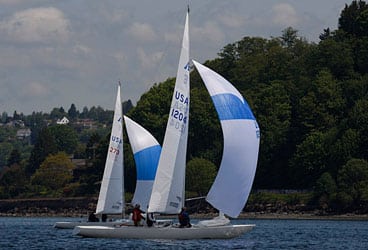
www.timwilkes.com| |After one day of racing, there are first-place ties in the Etchells (above), J/80, Moore 24, Santana 20, and San Juan 21 (Spinnaker) classes. For more photos, click here| That’s not to say today’s weather wasn’t beautiful– with clear skies and stunning views– and it’s certainly not to say that the racing wasn’t tight. The 17 classes racing today completed two or three races each, with first-place ties resulting in the J/80, Moore 24, Santana 20, Etchells, and San Juan 21 (Spinnaker) classes.
After racing, I caught up with a number of happy crews, not a whiner in sight. Gene Brown and Pete Bristow, who crewed aboard Edward Pinkham’s J/109 Jeopardy, were pleased with their boathandling. “Any day we don’t have trouble with our spinnaker sets and takedowns,” said Brown, “that’s a good day.”
Spinnaker work was also the focus on the San Juan 21 Bulls-eye, skipper Alan Bock and his crew, Mary, were sailing their first races as part of the class’ spinnaker division. The fact that they were still speaking to one another after a day learning the ins and outs and ups and downs of flying the kite indicates that the experience was a full success.
Over a plate of tasty, local barbeque, I spoke with Jack Seznick, who grew up on the bluff behind the Corinthian YC and reckons he’s been sailing these waters for thirty years. For the past three years, he’s been working with the crew of the J/109 J-Tripper, co-skippered by Dave Dack and Rick Nordquist. Before purchasing their J/109, Dack and Nordquist were only occasional racers. Since Seznick hopped aboard, however, the team has made drastic improvements to their boathandling and their scoreline. They currently sit in third place in the six-boat division. Seznick finds the steep part of the learning curve extremely rewarding. “When I joined the team,” he says, “I told the guys, ‘I want to be a part of this crew, but we’ve got to keep it fun.'”
I tried to glean a little local knowledge from the crews of the C&C 115s Elusive and Grey Boat, skippered by, respectively, Jeff Whitney and Dan Krier. Although there are only five boats racing this weekend, the region’s C&C 115 scene is thriving. They race year-round, sailing through the snow and cold and dark of January and soaking up the relatively balmy, 60-degree days of May. As in other tidal locales, the key to success is often deciding where to position oneself in relation to the fast-moving current in the middle of the Sound. At times, there is a “toilet bowl” effect, as the tide flowing out of Lake Union and through the locks moves through the marinas and swirls out along the shore, providing for a peculiar, near-shore lift. Today, however, the C&C racers all agreed: “It was a total crapshoot.”
Racing gets underway for the keelboat classes today. Jim Martinez from Loose Nuts tells us what to watch for for in the eight-boat Santana 20 fleet:
“One storyline of interest might be with the seven boats coming up from Eugene, Oregon, as part of the Santana 20 NW District Championship. This is a very competitive group, with three boats vying for the lead in the final race last year. Steve Orsini of Anacortes, Wash., did a great job winning the entire NOOD Regatta, but it was a battle. Expect the Oregon racers to bring lots of excitement to the very competitive Santana 20 fleet.”
May 7
I’m looking forward to making my first trip to Seattle, birthplace of my all-time hero, Jimi Hendrix. Rock-and-roll won’t be at the top of my agenda, however, as I’ll be covering the Sperry Top-Sider Seattle NOOD and doing my best to dish the dirt on the regatta’s 28 classes.
Looking for potential storylines, I sent out a mass email to the class coordinators yesterday. So far, I’ve received several enthusiastic responses from sailors with excellent story ideas. Here are some examples:
Stacey Wilson, Deception Mini 12
“Our class enables folks of all ages to sail. I am 51 and one of the younger sailors in the class. We have one member who is 91 years old, Harry McGuane, who sails regularly. In fact he placed second in last weeks series just seven days after getting out of the hospital with double pneumonia!”
Jerry Diercks, J/105
“There may be an interesting story in the fact that Cyan and Bill Baldwin raced against Last Tango and JP Peterson when they all lived on Long Island Sound. They now bring that rivalry and camaraderie to the West Coast.”
Diercks also related some news of his own, specifically, his decision to improve his boat preparation. “On the J105 this means having the keel and rudder templated and faired. I have learned that the factory keel and rudder are not always symmetrical or evenly shaped. Though the difference may be quite small, it does seem to play a part. Delirium is out of the water right now having that work done…Will the newly faired keel and rudder make a difference? Will there be a drastic learning curve for my driving after this work? Stay tuned.”
Chris Popich, San Juan 21
“One of the reasons we decided to put this regatta on our schedule was to show local sailors that we are still out here and active. Plus, as we found out last year, it was way too fun to miss. As a class. we seem to be on a upswing right now, which is not bad for a boat that’s been out of production for 23 years. Next year will mark the 40th anniversary of the SJ21. There are still lots of them out there waiting for some TLC, but they’ll cost you a whopping $2,000 – $4,000.
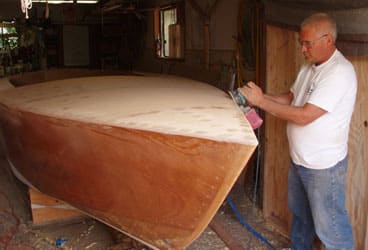
www.thunderbirdsailing.org| |Duane Emmott built his new Thunderbird, Thunderbaby, in his garage. The boat will make it’s major-regatta debut at the Seattle NOOD. For more photos, click here.| Locally, Fleet 1 has around 12 to 15 active boats. We’re somewhat of a nomadic group, choosing to set up and run our own races on Puget Sound and local lakes. We set out marks and starting pins and one of the boats runs the horn. It’s very informal, but we usually get three or four races in an afternoon. With six Saturday races in the spring and six fall races, plus four traveling regattas, we’ll rack up over 70 starts in a season.”
Alyssa Farber, Thunderbird
“Duane Emmott launched 1266 last summer at the 50th Rendevous in Gig Harbor. He will be racing her at the NOOD, his first major regatta with the new boat. Duane grew up on a T-bird named Kalau that his dad built in the 60s and, not to be outdone by good ol’ Dad, he built Thunderbaby in his garage in the tradition of the original T-birds.”
For photos of Emmott’s build, click here.

